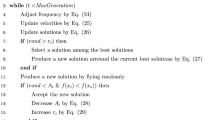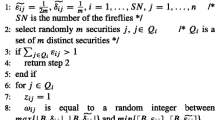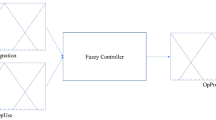Abstract
This paper deals with a multiperiod multiobjective fuzzy portfolio selectiossn problem based on credibility theory. A credibilistic multiobjective mean-VaR model is formulated for the multiperiod portfolio selection problem, whereby the return is quantified by the credibilistic mean and the risk is measured by the credibilistic VaR. We also consider liquidity, cardinality, and upper and lower bound constraints to obtain a more realistic model. Furthermore, to solve the proposed model efficiently, an improved multiobjective bat algorithm termed IMBA is designed, in which three new strategies, i.e., the global best solution selection strategy, candidate solution generation strategy, and competitive learning strategy, are proposed to increase the convergence speed and improve the solution quality. Finally, comparative experiments are presented to show the applicability and superiority of the proposed approaches from two aspects. First, the designed IMBA is compared with seven typical algorithms, i.e., multiobjective particle swarm optimization, multiobjective artificial bee colony, multiobjective firefly algorithm, multiobjective differential evolution, multiobjective bat, the non-dominated sorting genetic algorithm (NSGA-II) and strength pareto evolutionary algorithm 2 (SPEA2), on a number of benchmark test problems. Second, the applicability of the proposed model to practical applications of portfolio selection is given under different circumstances.







Similar content being viewed by others
References
Babu BV, Chakole PG, Mubeen JHS (2005) Multiobjective differential evolution (MODE) for optimization of adiabatic styrene reactor. Chem Eng Sci 60(17):4822–4837
Bansal S, Singh AK, Gupta N (2017) Optimal golomb ruler sequences generation for optical WDM systems: a novel parallel hybrid multiobjective bat algorithm. J Inst Eng 98(1):1–22
Chen W (2015) Artificial bee colony algorithm for constrained possibilistic portfolio optimization problem. Physica A 429:125–139
Chen W, Xu W (2019) A hybrid multiobjective bat algorithm for fuzzy portfolio optimization with real-world constraints. Int J Fuzzy Syst 21(1):291–307
Chen W, Li D, Liu YJ (2019) A novel hybrid ICA-FA algorithm for multiperiod uncertain portfolio optimization model based on multiple criteria. IEEE Trans Fuzzy Syst 27(5):1023–1036
Chen W, Xu H, Jia L, Gao Y (2021) A machine learning model for Bitcoin exchange rate prediction using economic and technology determinants. Int J Forecast 37(1):28–43
Chen W, Jiang M, Zhang WG, Jia L (2021) A novel graph convolutional feature based convolutional neural network for stock trend prediction. Inf Sci. https://doi.org/10.1016/j.ins.2020.12.068
Chen W, Xu H, Chen Z, Jiang M (2020) A novel method for time series prediction based on error decomposition and nonlinear combination of forecasters. Neurocomputing. https://doi.org/10.1016/j.neucom.2020.10.048
Chen W, Zhang H, Mehlawat MK, Jia L (2020) Mean-variance portfolio optimization using machine learning-based stock price prediction. Appl Soft Comput. https://doi.org/10.1016/j.asoc.2020.106943
Deb K (1999) Multiobjective genetic algorithms: problems difficulties and constuction of test problem. Evol Comput 7(3):205–230
Deb K, Pratap A, Agarwal S, Meyarivan T (2002) A fast and elitist multiobjective genetic algorithm: NSGA-II. IEEE Trans Evol Comput 6(2):182–197
Dehghani H, Bogdanovic D (2018) Copper price estimation using bat algorithm. Resour Policy 55:55–61
Gong X, Yu C, Min L, Ge Z (2021) Regret theory-based fuzzy multi-objective portfolio selection model involving DEA cross-efficiency and higher moments. Appl Soft Comput 100:106958
Guo S, Yu L, Li X, Kar S (2016) Fuzzy multiperiod portfolio selection with different investment horizons. Eur J Oper Res 254:1026–1035
Gupta P, Inuiguchi M, Mehlawat MK, Mittal G (2013) Multiobjective credibilistic portfolio selection model with fuzzy chance-constraints. Inf Sci 229:1–17
Gupta P, Mittal G, Mehlawat MK (2014) A multicriteria optimization model of portfolio rebalancing with transaction costs in fuzzy environment. Memetic Comp 6(1):61–74
Jalota H, Thakur M, Mittal G (2017) A credibilistic decision support system for portfolio optimization. Appl Soft Comput 59:512–528
Jiang M, Chen W, Li X (2020) S-GCN-GRU-NN: a novel hybrid model by combining a spatiotemporal graph convolutional network and a gated recurrent units neural network for short-term traffic speed forecasting. J Data Inform Manag. https://doi.org/10.1007/s42488-020-00037-9
Jiang M, Jia L, Chen Z, Chen W (2020) The two-stage machine learning ensemble models for stock price prediction by combining mode decomposition, extreme learning machine and improved harmony search algorithm. Ann Oper Res. https://doi.org/10.1007/s10479-020-03690-w
Jorion P (1996) Measuring the risk in value at risk. Financ Anal J 52(6):47–56
Konno H, Yamazaki H (1991) Mean-absolute deviation portfolio optimization model and its applications to Tokyo Stock Market. Manag Sci 37(5):519–531
Krink T, Paterlini S (2011) Multiobjective optimization using differential evolution for real-world portfolio optimization. Comput Manag Sci 8(1–2):157–179
Kumar D, Mishra KK (2017) Portfolio optimization using novel covariance guided artificial bee colony algorithm. Swarm Evol Comput 33:119–130
León T, Liern V, Vercher E (2002) Viability of infeasible portfolio selection problems: a fuzzy approach. Eur J Oper Res 139(1):178–189
Liagkouras K, Metaxiotis K (2018) Multiperiod mean-variance fuzzy portfolio optimization model with transaction costs. Eng Appl Artif Intell 67:260–269
Liagkouras K, Metaxiotis K (2019) Improving the performance of evolutionary algorithms: a new approach utilizing information from the evolutionary process and its application to the fuzzy portfolio optimization problem. Ann Oper Res 272(1–2):119–137
Liang H, Liu Y, Li F, Shen Y (2018) A multiobjective hybrid bat algorithm for combined economic/emission dispatch. Int J Electr Power Energy Syst 101:103–115
Liu BD, Liu YK (2002) Expected value of fuzzy variable and fuzzy expected value models. IEEE Trans Fuzzy Syst 10(4):445–450
Liu YJ, Zhang WG, Wang JB (2016) Multiperiod cardinality constrained portfolio selection models with interval coefficients. Ann Oper Res 244(2):545–569
Liu YJ, Zhang WG, Zhang Q (2016) Credibilistic multiperiod portfolio optimization model with bankruptcy control and affine recourse. Appl Soft Comput 38:890–906
Liu YJ, Zhang WG, Gupta P (2018) International asset allocation optimization with fuzzy return. Knowl Based Syst 139:189–199
Lwin K, Qu R, Kendall G (2014) A learning-guided multiobjective evolutionary algorithm for constrained portfolio optimization. Appl Soft Comput 24:757–772
Lwin K, Qu R, MacCarthy BL (2017) Mean-VaR portfolio optimization: a nonparametric approach. Eur J Oper Res 260(2):751–766
Macedo LL, Godinho P, Alves MJ (2017) Mean-semivariance portfolio optimization with multiobjective evolutionary algorithms and technical analysis rules. Expert Syst Appl 79:33–43
Markowitz H (1952) Portfolio selection. J Finance 7(1):77–91
Markowitz H (1959) Portfolio selection. Wiley, New York
Meghwani SS, Thakur M (2018) Multiobjective heuristic algorithms for practical portfolio optimization and rebalancing with transaction cost. Appl Soft Comput 67:865–894
Mehlawat MK (2016) Credibilistic mean-entropy models for multiperiod portfolio selection with multi-choice aspiration levels. Inf Sci 345:9–26
Mehlawat MK, Gupta P (2014) Fuzzy chance-constrained multiobjective portfolio selection model. IEEE Trans Fuzzy Syst 22(3):653–671
Mishra SK, Panda G, Majhi R (2014) Constrained portfolio asset selection using multiobjective bacteria foraging optimization. Oper Res 14(1):113–145
Mishra SK, Panda G, Majhi B (2016) Prediction based mean-variance model for constrained portfolio assets selection using multiobjective evolutionary algorithms. Swarm Evol Comput 28:117–130
Mohebbi N, Najafi AA (2018) Credibilistic multiperiod portfolio optimization based on scenario tree. Physica A 492(15):1302–1316
Osaba E, Yang XS, Diaz F, Lopez-Garcia P, Carballedo R (2016) An improved discrete bat algorithm for symmetric and asymmetric traveling salesman problems. Eng Appl Artif Intell 48:59–71
Philippatos GC, Wilson CJ (1972) Entropy, market risk, and the selection of efficient portfolios. Appl Econ 4(3):209–220
Reyes-Sierra M, Coello CA (2006) Multiobjective particle swarm optimizers: a survey of the state-of-the-art. Int J Comput Intell Res 2(3):287–308
Rockfeller T, Uryasev S (2000) Optimization of conditional VaR. J Risk 2:21–24
Rodrigues D, Pereira LA, Nakamura RY, Costa KA, Yang XS, Souza AN, Papa JP (2014) A wrapper approach for feature selection based on bat algorithm and optimum-path forest. Expert Syst Appl 41(5):2250–2258
Saad A, Khan SA, Mahmood A (2018) A multiobjective evolutionary artificial bee colony algorithm for optimizing network topology design. Swarm Evol Comput 38:187–201
Saborido R, Ruiz AB, Bermúdez JD, Vercher E, Luque M (2016) Evolutionary multiobjective optimization algorithms for fuzzy portfolio selection. Appl Soft Comput 39:48–63
Sharma N, Sharma H, Sharma A (2018) Beer froth artificial bee colony algorithm for job-shop scheduling problem. Appl Soft Comput 68:507–524
Speranza MG (1993) Linear programming models for portfolio optimization. Finance 14:107–123
Tsaur RC (2013) Fuzzy portfolio model with different investor risk attitudes. Eur J Oper Res 227(2):385–390
Van Veldhuizen D (1999) Multiobjective evolutionary algorithms: classifications, analyzes, and new innovations. Air Force Institute of Technolnology, Dayton, OH, Tech. Rep. AFIT/DS/ENG/99-01
Van DA, Gary V, Lamont B (1998) Multiobjective evolutionary algorithm research: a history and analysis. Evol Comput 8(2):125–147
Wang S, Watada J (2011) Two-stage fuzzy stochastic programming with value-at-risk criteria. Appl Soft Comput 11(1):1044–1056
Wang B, Li Y, Wang S, Watada J (2018) A multiobjective portfolio selection model with fuzzy value-at-risk ratio. IEEE Trans Fuzzy Syst 26(6):3673–3687
Watada J (1997) Fuzzy portfolio selection and its application to decision making. Tatra Mt Math Publ 13(4):219–248
Yang XS (2010) A new metaheuristic bat-inspired algorithm. In: Nature inspired cooperative strategies for optimization, NICSO 2010, Springer, pp 65–74
Yang XS (2011) Bat algorithm for multiobjective optimisation. Int J Bioinsp Comput 3:267–274
Yang XS, Gandomi AH (2012) Bat algorithm: a novel approach for global engineering optimization. Eng Comput 29(5):464–483
Yao N, Hong-Chan LI (2017) Hybrid bat algorithm for multiobjective flexible job shop scheduling problem. Microelectron Comput 34(3):25–29
Yue W, Wang Y (2017) A new fuzzy multiobjective higher order moment portfolio selection model for diversified portfolios. Physica A 465:124–140
Zadeh LA (1965) Fuzzy sets. Inf Control 8(3):338–353
Zadeh LA (1978) Fuzzy sets as a basis for a theory of possibility. Fuzzy Sets Syst 1(1):3–28
Zhou JD, Li X (2020) Mean-semi-entropy portfolio adjusting model with transaction costs. J Data Inform Manag 2:121–130
Zhou X, Wang J, Yang X, Lev B, Tu Y, Wang S (2018) Portfolio selection under different attitudes in fuzzy environment. Inf Sci 462:278–289
Zhou X, Zhao X, Liu Y (2018) A multiobjective discrete bat algorithm for community detection in dynamic networks. Appl Intell 48(9):3081–3093
Zitzler E, Thiele L (1999) Multiobjective evolutionary algorithms: a comparative case study and the strength Pareto approach. IEEE Trans Evol Comput 3(4):257–271
Zitzler E, Deb K, Thiele L (2000) Comparison of multiobjective evolutionary algorithms: empirical results. Evol Comput 8(2):173–95
Acknowledgements
This research was supported by the Postgraduate Academic Newcomer Program of Capital University of Economics and Business of China (No. 2021XSXR05). The corresponding author, Wei Chen, acknowledges the support through the National Natural Science Foundation of China (No. 72071134), the Project of High-level Teachers in Beijing Municipal Universities in the Period of 13th Five-year Plan (CIT&TCD20190338), the Humanity and Social Science Foundation of Ministry of Education of China (No. 19YJAZH005).
Author information
Authors and Affiliations
Corresponding author
Ethics declarations
Conflict of interest
The authors declare that there is no conflict of interest regarding the publication of this article.
Ethical approval
This article does not contain any studies with human participants or animals performed by any of the authors.
Additional information
Publisher's Note
Springer Nature remains neutral with regard to jurisdictional claims in published maps and institutional affiliations.
Rights and permissions
About this article
Cite this article
Jiang, M., Liu, W., Xu, W. et al. Improved multiobjective bat algorithm for the credibilistic multiperiod mean-VaR portfolio optimization problem. Soft Comput 25, 6445–6467 (2021). https://doi.org/10.1007/s00500-021-05638-z
Published:
Issue Date:
DOI: https://doi.org/10.1007/s00500-021-05638-z




